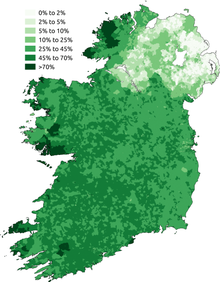Irish Gaelic language
| Irish | |
|---|---|
| Gaeilge | |

"Gaelach" in traditional Gaelic type
|
|
| Pronunciation | [ˈɡeːlʲɟə] |
| Native to | Ireland |
| Region | Ireland, mainly Gaeltacht |
|
Native speakers
|
74,000 in Ireland (2016) L2 speakers: 1,761,420 in Republic of Ireland (2016), 104,943 in Northern Ireland (2011) Total: 1,154,923 (17.57% of Ireland (NI & Republic)) |
|
Early forms
|
|
|
Standard forms
|
An Caighdeán Oifigiúil |
|
Latin (Irish alphabet) Irish Braille |
|
| Official status | |
|
Official language in
|
|
|
Recognised minority
language in |
|
| Regulated by | Foras na Gaeilge |
| Language codes | |
| ISO 639-1 | ga |
| ISO 639-2 | gle |
| ISO 639-3 | |
| Glottolog | iris1253 |
| Linguasphere | 50-AAA |

Proportion of respondents who said they could speak Irish in the Republic of Ireland and Northern Ireland censuses of 2011.
|
|
Irish (Gaeilge), also referred to as Gaelic or Irish Gaelic, is a Goidelic language (Gaelic) of the Indo-European language family originating in Ireland and historically spoken by the Irish people. Irish is spoken as a first language by a small minority of Irish people, and as a second language by a larger group of non-native speakers. Irish enjoys constitutional status as the national and first official language of the Republic of Ireland, and is an officially recognised minority language in Northern Ireland. It is also among the official languages of the European Union. The public body Foras na Gaeilge is responsible for the promotion of the language throughout the island of Ireland. Irish was the predominant language of the Irish people for most of their recorded history, and they brought it with them to other regions, notably Scotland and the Isle of Man, where Middle Irish gave rise to Scottish Gaelic and Manx respectively. It has the oldest vernacular literature in Western Europe.
In An Caighdeán Oifigiúil (the official written standard) the name of the language is Gaeilge (Irish pronunciation: [ˈɡeːlʲɟə]). Before the spelling reform of 1948, this form was spelled Gaedhilge; originally this was the genitive of Gaedhealg, the form used in Classical Irish. Older spellings of this include Gaoidhealg in Classical Irish [ˈɡeːʝəlˠɡ] and Goídelc [ˈɡoiðelˠɡ] in Old Irish. The modern spelling results from the deletion of the silent dh in the middle of Gaedhilge, whereas Goidelic languages, used to refer to the language family including Irish, comes from Old Irish.
...
Wikipedia
